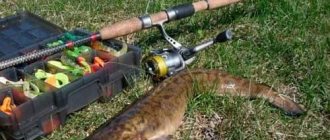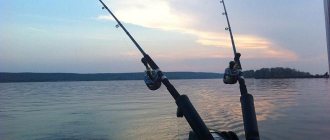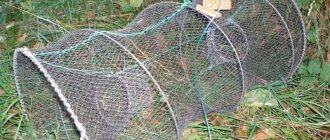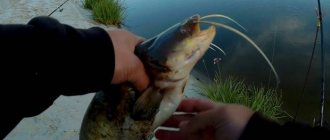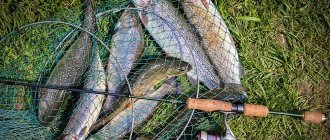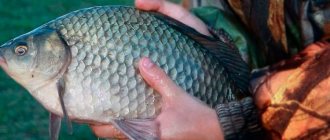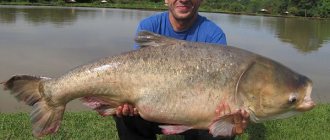Small rivers. No matter how they are called “paddling pool” or “toad pond”, and some even look like small canals, there is something attractive and beautiful about them. For example, I started my journey into the world of spinning with just such a reservoir. I treat small rivers with trepidation. And until now, for many years now, I have not shied away from picking up a spinning rod and going to familiar places. Remember your childhood, tell stories by the fire and just admire nature.
But if you think that everything is so simple here, then you are deeply mistaken, because a small river dictates special requirements for the choice of gear, and in particular for a spinning rod. This is what we will talk about now.
Length
Small rivers are called small because they are small in size, and in some places you can touch the opposite bank with the tip of a fishing rod. Fishing is carried out both “underfoot” and at some distance from the coastline. The width of the river, its depth and the nature of the flow leaves a certain imprint on the choice of fishing rod. I'll explain now. When fishing in the “jabovnik”, you need to use a not very long, but quite powerful spinning rod that can withstand critical loads.
Why is it preferable to use a short spinning rod? It's simple. Firstly, with a short spinning rod it is more convenient to overcome all kinds of thickets and bushes, which, by the way, are present in abundance on such reservoirs. Secondly, with a short spinning rod it is easier to animate a number of baits that require active animation, for example, a wobbler. Well, and thirdly, on small rivers there is simply no need for a long rod, since there is no need for long casting, and all fishing is done, roughly speaking, closely.
For several years now I have been using only classic bass “pegs” on reservoirs of this type. They are quite loud and powerful. I have a length from 190 to 220 centimeters. And believe me, the length of 220 centimeters is enough for your eyes. Throwing the bait 40-50 meters from the shore (although more often such a long cast is not required at all due to the nature of the reservoir) is quite possible. Most often I fish with a GAD Gancho spinning rod with a length of 198 centimeters and a weight of 10.5 to 32 grams. It is powerful, forgiving of many mistakes, and most importantly, wildly versatile, but we’ll talk about that a little later, and now let’s move on to the test border.
Features of spinning fishing on small rivers
Effective spinning fishing on small rivers implies a preliminary study of the conditions of the reservoir. It makes no sense to put plant baits if there are no omnivorous or peaceful fish in the river. The fisherman's only catch will be small fry, which are best released. You also need to be careful with animal baits; too large baits scare the fish, and small baits attract high water, which prevents you from catching worthy prey. The right tactics, combined with an understanding of the peculiarities of wiring, are the key to a good catch.
There is no point in placing large baits on small rivers
To avoid wasting time, it is better to first talk with local residents and get to know the inhabitants of the reservoir.
Spinning fishing in winter on small rivers begins earlier than on large reservoirs, but in the event of severe frosts, the fish become extremely passive and do not bite the bait well. The only way to get a good catch is to find a hole, there will probably be fish in it.
Fishing technique
There is nothing difficult in identifying promising fishing spots on most streams, since many fish prefer the same places.
Finding promising fishing spots on a small river is quite easy. First of all this:
- channel turns. Here there are pits in which large fish wait for food to be washed away by the current. There are a lot of predator ambushes around the turn; you can catch a lot of fish with a spinning rod;
- areas with reverse flow;
- underwater vegetation. Wiring along reeds, water lilies, and algae often leads to bites;
- riffles. They are a favorite habitat for chub.
Fishing on small rivers with an ultralight spinning rod can be planned even at home. Having a topographic map in hand, a fisherman can actually plan a route and find the most catching places.
Important! Even in a promising place, it will not be possible to achieve a catch if you ignore camouflage. The fish, noticing a person, leaves the feeding area and goes to a safe place.
It’s quite easy to find promising fishing spots on a small river
Wiring Features
It is impossible to count the number of methods for guiding a spinning rod; a separate wiring method has been developed for each type of attachment. The simplest method is required when using spinners; it is enough to move them smoothly or with slight delays. The rest of the baits are animated in different ways, so wobblers are suitable for uniform, jerky movements, and are also performed with delays.
Read more
How to catch rudd with a spinning rod?
To animate silicone baits, it is advisable to use:
- standard, stepped wiring for jigs;
- pulling the bait with periodic stopping and raising the bait using the top of the fishing rod;
- smooth;
- dragging in the bottom layers of water.
The choice is influenced not only by the type of bait, but also by the behavior of the fish. If the predator does not bite or does it reluctantly, we recommend slowing down the retrieve and also holding the bait for long periods of time.
Important! In your spinning kit, you need to have polarized glasses - this is a useful tool, as it allows you to examine fish underwater and control the movement of the bait depending on the behavior of the prey.
Test
It is the test that determines the power of the spinning rod. In my case it is 10.5-32 grams. To be honest, there is no need to have a spinning rod with such a test. I took a powerful spinning rod just so as not to stand on ceremony with the pike. Gancho plays the role of the uprooter. Thanks to this power, I can easily force fishing in the most “strong” places. This is why powerful spinning rods are required when fishing on a small river. And so for a “toadfisher” it is enough to have a rod with a length of 190 centimeters and a test weight of up to 17-18 grams. Such a test border will allow you to use exactly the range of baits that is so necessary when fishing on a small river. These include wobblers in the size of 80-110 millimeters, unloaded rubber and, of course, a light jig. In addition to Gancho, the ideal shorty for a small river would be Pontoon 21 Resonada with a length of 213 centimeters and a dough from 4 to 18 grams. For me, this is just the perfect rod. It is powerful, very loud, sending and helps to animate the necessary baits. And his type is my favorite – American.
Very often it is necessary to use the “crane” method, since fishing is often carried out from a steep bank, and it is simply impossible to “feed” the bait to the fish in any other way. Therefore, after biting and hooking, we lift the fish on a spinning rod. It’s simply not possible to perform such an action with a flimsy and delicate spinning rod, but Gancho and Resonada cope with a similar task with a bang. Power and the right length are the keys to a good spinning rod for a small river.
Gear for fishing in small bodies of water
Fishing on small rivers is carried out mainly with float gear, in some cases bottom gear is also used. The donka for fishing on a small river should be light and sensitive. The best choice is to buy a light feeder or picker.
Fishing with a feeder is advisable if the casting range is about twenty meters. At shorter distances, a short picker is preferred.
With a picker you can fish shallow areas remote from the angler, while the cast is often made not across the watercourse, but at an acute angle to it. This allows you to fish in shallow water locations, which are impossible to get close to without spooking the fish.
A picker will also help when fishing at the confluence of two rivers. The place is quite promising, but a float rod is not always acceptable here. The fact is that promising places may be on both sides of watercourses, and the length of the float rod may not be enough. Moreover, the banks in these places may be swampy, or overgrown with reeds, bushes, or thick grass. By positioning yourself with a picker on a dry bank upstream, you can comfortably fish the entire location in question.
A picker is also convenient when fishing a hole at a bend in the channel. The hole itself can often be fished with a fly rod, but the edge of the thickets in the opposite shallow area is also of interest. If for some reason the bite in the hole has stopped, and this indicates that the fish were spooked either by the fisherman himself or by an approaching predator, it is quite possible to catch fish in the surrounding shallow waters without changing position.
Read more about how to choose a picker.
Float fishing on rivers
Fishing with a float rod is not particularly tricky. The spindle-shaped float is selected according to the current. It is desirable to have a thin keel to ensure stability of the float. In quiet holes there is practically no current, so elongated floats, for example, a classic feather, are quite suitable. In shallow water areas, small spherical floats with minimal carrying capacity are used.
Wiring fishing on small rivers is practiced only in the spring, while the water is high and the vegetation has not yet risen. In summer, the rivers become shallow, overgrown with grass, and there is practically no possibility of fishing with wire.
The choice of hooks, leashes and other equipment elements in float fishing does not have any specifics for small rivers, so we will not dwell on this issue separately.
Build
This feature, as a rule, distinguishes all spinning rods from each other. I will not talk about what types of systems there are, what they are good for and what they are not. Only essentially, only a small river. And so, for a small river, the most suitable rod would be a spinning rod with a fast action - fast. Why fast? The fact is that spinning rods with such rigidity are as versatile as possible, and this is the most important thing. We can’t take three spinning rods with us fishing at once, no, of course, take them if you want, but I limit myself to one and it’s enough for me. From the point of view of mobility, carrying three or two spinning rods with different directions will be, to put it mildly, stupid.
A spinning rod with a fast action is well suited for fishing with both wobblers and rubber in all its variations. By the way, my favorite Gancho has a fast action, which makes it a real all-rounder.
Baits used on small rivers
The choice of bait depends both on the object being fished and the characteristics of the reservoir, and on the individual preferences of each particular angler. Almost all existing baits can be used:
- Oscillating and rotating spoons.
Photo 2. Suitable turntables. - Wobblers.
Photo 3. Small wobblers. - Edible silicone.
- Jigs.
- Spinnerbaits.
- Equipment options
Important! If you plan to fish in an unfamiliar body of water, then it is advisable that the spinning angler has at his disposal the greatest possible variety of both types and colors of bait.
Each angler makes his own choice, based on his own preferences, but it should be borne in mind that on a small river in most cases there is no point in using large baits. Although trophy fish are found in such reservoirs, they are rare, and high fishing pressure leads to the fact that the largest catches are made with small baits.
Sensitivity
In view of the fact that fishing, whenever possible, is most often carried out closely and all pike attacks occur before our eyes, such a criterion as sensitivity can be omitted and not be too selective in this regard. But there is a certain peculiarity. Close-up fishing can be done both with unloaded rubber and with wobblers. And whether the form “shocks” or not is a secondary matter. But when we fish with a light jig with a Cheburashka weighing up to 5 grams, sensitivity comes to the fore. We need to have a clear understanding of what is going on at the “other end”. This is where spinning rods with a super fast extra fast action and the most informative tip come into play. By the way, the previously mentioned Resonada series has such a structure, but at the same time it copes well with wobblers and even more so with light jigs, which cannot fail to amaze the fastidious angler.
So if you plan to fish on a small river with a light jig, then be sure to keep in mind that sensitivity in this case comes to the fore. But if you wish, you can find the treasured middle ground.
Underwater rocks
It seems that everything is fine, and we have decided on the length, action and test, you can take a spinning rod and go to the river, but no. It is important to know one more interesting point. Well, who knows. Be at least familiar with it.
Since on a small river it is preferable to fish with “pegs”, you will encounter some difficulties regarding fishing.
Now I will try to interpret everything in detail. To the extent that a spinning rod with a fast action is very rigid and this is its charm, it also has a downside. An excessively stiff rod helps speed up the landing, but “drains” the fish. There are, as it were, two ways: either you give up comfortable fishing and take a spinning rod with a “live” form, or you are ready to sacrifice gatherings. On a small river, bites occur quite often “under your feet”; the pike literally tears its lip due to an intractable form.
That's the downside to bass pegs, but fortunately there is one option that will help you find that sweet spot. And this golden mean lies in one attractive series of the company Pontoon 21. TAYA spinning rod model TYS732M-T with a length of 220 centimeters and a dough weight from 4.5 to 17.5 grams. Truly a masterpiece and an ideal instrument for a small river. What is ideal and how does this rod differ from others, you ask. And I will answer that everyone. The action is fast, but this rod is more flexible and, if desired, can be bent all the way to the butt. The fish “sticks” to it and there are practically no escapes, of course, unless you deliberately pull the bait out of the predator’s mouth. At the same time, TAYA copes well with all baits within its test. It is not flimsy and moderately powerful, the form is clear, the tip is informative - a real all-rounder! There is no other way to say it.
And so, coming to the logical conclusion of the article, I would like to say once again about the best fishing rods for small rivers. This:
On small rivers with spinning
The turns of the river are clearly visible through the bare branches.
Photo: Alexey Kolomiets. After rummaging through my fishing diary, I recalled two fishing trips that happened in early April.
In both cases we caught a chub, so the probability of getting away from zero is quite high.
Well, no one has canceled perch and pike, which are always bycatch.
I can’t say or predict anything about the asp. All asp captures on this river happened very spontaneously, in different places and at different times, and never so early.
So, the main goal for me was and remains the chub.
I don’t remember where I heard a foreign proverb - fortune smiles on the brave, or something like that.
One could say differently - “He who doesn’t take risks, doesn’t drink champagne” - but no, that’s not it. There was no risk, and I was not looking for any victories. But I boldly went alone to the river quite early, not knowing what form I would find the river in - that’s where luck smiled at me!
The spring water did its job and the river entered its banks. Judging by the wet, sloping bank, this happened quite recently. The water itself is somewhat cloudy, but quite acceptable for catching chub, I think. In general, lucky!
Read the material “Fishing in ice water until the turbidity rises”
The first to “swim” was the Raiden Maguro wobbler. It just so happened that in the summer on this river it established itself as the most versatile. It is about a meter deep and the color is bright yellow.
And the first to react to him was a small pike. I chased him from the opposite bank. Apparently, she stood in ambush and waited. Well, that's great! Already gone from zero!
As expected, pike and perch should be included in the bycatch. But they are not as interesting to me as the chub. And I, having hung a belt bag with boxes, a folding landing net and with a camera in my bosom, went to wander along the river.
You have no idea how interesting this is! When the old reeds are nailed to the ground by the flood, and the new ones have not yet grown. When the tall coastal grass is just emerging from the wet ground. When the river is visible through the bare branches of trees. I can see everything and in some places I can crawl to the water.
I even discovered a very convenient and promising place at a bend in the river, which I couldn’t get to for several years due to a blockage of trees caused by floods.
And it’s also interesting to look at the places favored by beavers. Here you can see that they are having breakfast, here they are apparently building something, and in some places it is simply convenient for them to use the shore as a beach.
The first chub pecked just like a pike. From the opposite bank I felt an indistinct poke on the wobbler and then a characteristic attack. The chub is small, but that's something! This means that the big one is still active. All that remains is to find his parking spots and understand which wobbler is most attractive to him.
| The first chub confirmed the guesses. Photo: Alexey Kolomiets. |
The first thing the chub set his sights on was the Mottomo Chubber MR crank, that is, with the same depth as Maguro. So, should we continue fishing with MR or try to “look” deeper?
I decided to take a risk, because I had the cut with me. I attached exactly the same Mottomo Chubber to the leash, only bright yellow and with a DR depth, that is, with a working horizon of more than a meter. But bad luck, the third fish again turned out to be a pike.
Read the material “Spring presented a full set of trophies”
Well, that means it’s right that I always put a string leash in front of the wobbler. It seems to interfere with the play of the wobbler and, perhaps, negatively affects the chub’s liking for the bait in general, but the second chub did not notice the leash.
Interestingly, it took a bite approximately in the middle of the river on a fairly deep-water reach. It seemed to me that I had done everything right, that I had dived deeper. True, I don’t scratch the bottom, but I would like to. They say that in cold water the chub always stands at the very bottom.
And here it is, the long-awaited blunt blow in the middle of the river! Someone unceremoniously stopped the wobbler and, after thinking for a second, began to bend the spinning rod and go somewhere against the current. The clutch squeals, which means it is set.
I carefully watch the cord going into the water. It doesn’t wave its head – that means it’s not a pike! It is he! The big chub I came for! So he went towards the shore, to a small branch sticking out of the water.
I pull the spinning rod in front of me and try to turn it in the other direction - I succeed. I continue to fight. From time to time he makes jerks into the depths, but the spinning rod and clutch clearly monitor this disgrace.
I see him, picking up speed, walking towards some garbage, which is clearly stuck on some vegetation. I’m trying again not to let him in there and again I’m succeeding! Everything is going as well as possible! The landing net is on my belt, the shore is comfortable enough to catch fish and, most importantly, there is clean water where it can be tired.
And so, at what seems like the climax moment, a decent pike emerges from the depths and begins to somersault near the shore. Oh, my God! I feel some disappointment. But I already received pleasure from the sensations and experiences I received.
I take the pike with a lipgrip and go to the car, since I didn’t take the forceps with me. Picking out a wobbler from a toothy mouth with a stick without a yawn is funny, since I have already taken this lesson.
Surprisingly, all the tees above the designated wobbler were not damaged. I thought that the hooks would still bend - but no. Everything remained absolutely acceptable for further fishing.
| The tees were not damaged. Photo: Alexey Kolomiets. |
And the pike, as it turned out later, no longer contained caviar. Instead, I found two fish in my stomach: crucian carp and roach. And the pike weighed 2.5 kg, which is a very impressive size for a small river.
Read the material “How to catch a pike in the grass”
I have never caught such a big fish on the Mottomo Chubber DR. Well, thanks to him. By the way, I caught another pike and chub with this wobbler that day. Perhaps I just fished with it longer, perhaps it was better suited to these conditions than other wobblers.
| A 2.5 kg pike for a small river is a giant! Photo: Alexey Kolomiets. |
Interestingly, I didn’t see a single bite on the Smith Camion DR. Bright, small, butt wags as if wound up and stable - but no. I caught two pike and two chub with Mottomo wobblers; I didn’t even see a bite with other wobblers.
However, no, I’m lying. The last chub, the plumpest one, was caught on the Lucky Craft Clutch DR. I might have continued to fish with something that was clearly catching, but in one promising place the breeze was very disturbing and I did not reach the desired narrowing, in front of which the stream made a turn and formed three interesting places: a reverse current, a whirlpool and a quiet corner near the reeds.
| Third chub on LC Clutch DR. Photo: Alexey Kolomiets. |
The Clutch is a proven chub lure and is heavy enough to put where you need it. The place is quite familiar to me. Somewhere in the center last year there was a spreading snag under the water, to which I swam and took off my baits.
I didn’t really want to swim now. I also didn’t want to rely on the release, since the wobbler is not cheap. I tried to catch the supposed snag from memory (after all, it might not have been there after the flood) and somewhere to the right of this terrible place, near the bottom, that same small but weighty chub sat down. At the same time, the wobbler no, no, and scraped the bottom with a shovel.
But then the river told me: “Enough!” I didn't see another bite. I went around the river from the other side, fished near the piles of the old bridge, fished all the “tasty” places - not a single poke.
But I'm not offended. Rechka showed herself very well on the first date and even let herself be kissed, as I call it.
Read the material “Last Thrust: Sadness in the Soul”
But here's what confuses me. Three chub were caught with three different wobblers, in three completely different places and at different depths. It’s a pity that I so rarely go to this river in early spring.
| I thought that the bright color would play a role - no. Three chub were caught using different colors. Photo: Alexey Kolomiets. |
In a week the picture will be completely different. The apricot is blooming, the tulips are growing, the water is getting warmer and brighter, and the pre-spawning feast of the chub will begin.
This is also interesting and exciting, but early spring chub hunting is not the most productive, but the most intriguing.
Alexey Kolomiets, Volgograd. April 22, 2021 at 01:43 pm
